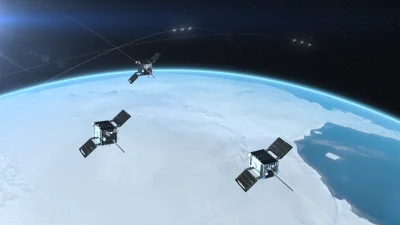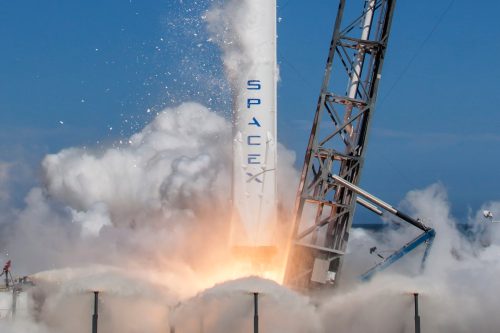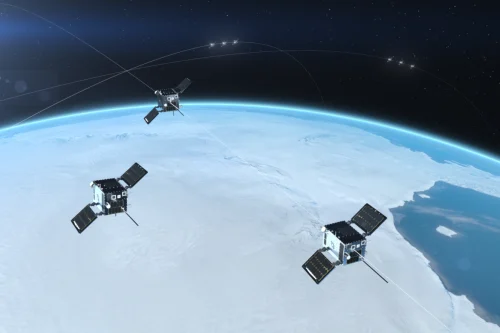HawkEye 360 LEO satellite constellation

| Position: | LEO |
| Operator: | HawkEye 360 |
| Launch operators: | Rocket Lab |
| SpaceX | |
| Launch vehicles: | Electron |
| Falcon 9 | |
| Launch date: | |
| Expected lifetime: | 10 Years |
The HawkEye 360 LEO satellite constellation is being built and operated by privately held American provider of satellite-based global transportation monitoring and communication services, HawkEye 360. The company uses a constellation of small satellites in low Earth orbit (LEO), to generate reports on wireless signals that can be used to track and monitor global transportation networks, assist with emergencies, as well as other data analytics services to Maritime-, Telecommunications- and Security & Defense companies.
The satellites will fly in a special formation facilitated by a novel water propulsion system. Each satellite (also referred to as a Hawk) in the cluster has a Software-Defined Radio (SDR) with the ability to detect a wide range of radio frequencies, and once all three satellites have picked up on a common signal, they can trilaterate that signal with accuracies dependent upon the terrain, signal and other factors.
On December 20th, 2018, HawkEye 360 launched the first set of Nano-satellites, known as the Pathfinder cluster, into orbit on SSO-A SmallSat Express ride-share mission aboard a Falcon 9 rocket, operated by SpaceX. The satellites, in both this first cluster as well as a later second cluster, were constructed by UTIAS Space Flight Laboratories.
On January 24th, 2021 HawkEye 360 successfully launched their second cluster of Nano-satellites on Spaceflight rideshare mission aboard of a Falcon 9 rocket operated by SpaceX. This second cluster of satellites was tested in July 2020, which was the last technical milestone before launch. The third cluster of Hawk LEO satellites (Hawk-3A, -3B and -3C) was launched on June 30th, 2021 with the Transporter-2 mission on a Falcon 9 rocket operated by SpaceX.
On April 1st, 2022 launch operator SpaceX orbited HawkEye’s fourth cluster of satellites on their Transporter-4 Rideshare Mission with a Falcon 9 rocket from the Cape Canaveral launch base in Florida.
On May 25th, 2022 the company launched its fifth cluster of satellites on the Transporter-5 Rideshare mission with a Falcon 9 rocket operated by SpaceX.
On January 24th 2023 another cluster of satellites were launched on an Electron launcher operated by Rocket Lab. This was the 1st Electron Mission from U.S. soil using NASA’s Wallops flight facility in Virginia that was developed to support U.S. Electron missions for government and commercial customers. The launch was scheduled for December 2022 but delayed due to bad weather conditions.
|
Satellite
|
Mission
|
Launch Date
|
Launcher
|
Launch Operator
|
|
|
|
|
|
|
|
Cluster 1 (Pathfinder)
– Hawk-1A – Hawk-1B – Hawk-1C |
SSO-A Express
|
Dec 20th, 2018
|
Falcon 9
|
SpaceX USA
|
|
|
|
|
|
|
|
Cluster 2
– Hawk-2A – Hawk-2B – Hawk-2C |
Transporter-1
|
Jan 24th, 2021
|
Falcon 9
|
SpaceX USA
|
|
|
|
|
|
|
|
Cluster 3
– Hawk-3A – Hawk-3B – Hawk-3C |
Transporter-2
|
June 30th, 2021
|
Falcon 9
|
SpaceX USA
|
|
|
|
|
|
|
|
Cluster 4
– Hawk-4A – Hawk-4B – Hawk-4C |
Transporter-4
|
April 1st, 2022
|
Falcon 9
|
SpaceX USA
|
|
|
|
|
|
|
|
Cluster 5
– Hawk-5A – Hawk-5B – Hawk-5C |
Transporter-5
|
May 25th, 2022
|
Falcon 9
|
SpaceX USA
|
|
|
|
|
|
|
|
Cluster 6
– Hawk-6A – Hawk-6B – Hawk-6C |
Virginia-Is-For-Launch-Lovers
|
Jan 24th, 2023
|
Electron
|
Rocket Lab, USA
|
|
|
|
|
|
|
|
Cluster 7
– Hawk-7A – Hawk-7B – Hawk-7C |
Transporter-7
|
Apr 15th, 2023
|
Falcon 9
|
SpaceX USA
|
|
|
|
|
|
|
|
Cluster 8
– Hawk-8A – Hawk-8B – Hawk-8C |
Bandwagon-1
|
Apr 7th, 2024
|
Falcon 9
|
SpaceX USA
|
|
|
|
|
|
|
|
Cluster 9
– Hawk-9A – Hawk-9B – Hawk-9C |
Bandwagon-1
|
Apr 7th, 2024
|
Falcon 9
|
SpaceX USA
|
|
|
|
|
|
|
|
Cluster 10
– Hawk-10A – Hawk-10B – Hawk-10C |
Transporter-11
|
Aug 16th, 2024
|
Falcon 9
|
SpaceX USA
|

